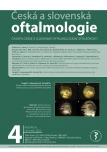VITAMIN D AND OPHTHALMOPATHIAS. A REVIEW
Authors:
P. Hribová 1; Š. Sotak 2
Authors‘ workplace:
Očná klinika LF UPJŠ a UN LP v Košiciach
1; I. interná klinika LF UPJŠ a UN LP v Košiciach
2
Published in:
Čes. a slov. Oftal., 78, 2022, No. 4, p. 153-156
Category:
Review Article
doi:
https://doi.org/10.31348/2021/31
Overview
The importance of vitamin D3 (hydroxycholecalciferol) as one of the liposoluble vitamins is known in the prevention and treatment of metabolic bone diseases (rickets, osteomalacia, osteoporosis). In recent years, however, information has increased on the importance of vitamin D3 in numerous organ systems and in the pathogenesis of various diseases, e. g. ophthalmopathies. The immunological functions of vitamin D3 are the subject of studies dealing with autoimmune optic nerve disorders and their results appear to have a positive effect on demyelinating diseases. It also plays an important role in maintaining the thickness of the retinal nerve fiber layer, but its additional administration has not been successful. Optical neuritis may be the first sign of multiple sclerosis. It appears that sufficient serum vitamin D3 levels may protect patients from deterioration in the form of a further attack of demyelination. The course of diabetic retinopathy is probably also influenced by vitamin D3, inter alia, by correlating the fact that its receptor and the enzymes of its metabolism are expressed on the retina. Low serum levels of vitamin D3 may even trigger age-related macular degeneration. Conversely, higher dietary intake of vitamin D3 may positively affect neovascularization. The optimal level of hydroxycholecalciferol is between 60 and 200 nmol /l, the severe deficit represents a decrease below 25 nmol/l. The body can normally produce up to 10,000 IU of this vitamin after exposure to sunlight. However, the demonstration of its protective character in connection with the mentioned diseases of the retina and optic nerve will require a sufficient number of studies to confirm the facts found so far about this rediscovered vitamin.
Keywords:
vitamin D – ophtalmopathias
Sources
1. Jackuliak P. Pleiotropné účinky vitamínu D. MEDICUS news. 2019;1(3):49-52. Slovak.
2. Jackuliak P. Pleiotropné účinky vitamínu D. Lekárnické listy. 2020;22(2):38-39. Slovak.
3. Šterzl I. Vliv vitaminu D na imunitní mechanismy. Interní Med. 2014;16(3):110-112. Czech.
4. Lazúrová I, Figurová J, Dravecká I. Vitamín D a syndróm polycystických ovárií. Vnitř Lék. 2016;62(S3):87-91. Slovak.
5. Smaha J, Kužma M, Jackuliak P, Payer J. Suplementácia vitamínu D ako dôležitý faktor v prevencii a liečbe ochorenia COVID-19: aké máme dôkazy? Vnit Lék. 2020;66:494-500. Slovak.
6. Rodney C, Rodney S, Millis R. Vitamin D and demyelinating diseases: Neuromyelitis optica (NMO) and multiple sclerosis (MS) [internet]. Hindawi Autoimmune Diseases; 2020. [cited 2020 Nov 18]. Available from: //https://www.hindawi.com/journals/ ad/2020/8718736/
7. Shaygannejad V, Maljaei MB, Bank SS, Mirmosayyeb O, Maracy MR, Askari G. Association between sun exposure, vitamin D intake, serum vitamin D level, and immunoglobulin G level in patients with neuromyelitis optica spectrum disorder. Int J Prev Med. 2018;9:68.
8. Burton JM, Eliasziw M, Trufyn J, Tung C, Carter G, Costello F. A prospective cohort study of vitamin D in optic neuritis recovery. Mult Scler. 2016;23(1):82-93
9. Burton JM, Trufin J, Tung C, Eliasziw, Costello F. The Role of Vitamin D Status in Optic Neuritis – An Update. Neurology. 2016;80:7.
10. Gungor A, Ates O, Bilen H, Kocer I. Retinal Nerve Fiber Layer Thickness in Early-Stage Diabetic Retinopathy With Vitamin D Deficiency. IOVS. 2015;56:6433-6437.
11. Salari M, Janghorbani M, Etemadifar M, Dehghani A, Razmjoo H, Naderian G. Effects of vitamin D on retinal nerve fiber layer in vitamin D deficient patients with optic neuritis: Preliminary findings of a randomized, placebo-controlled trial. J Res Med Sci. 2015;4:372-378.
12. Derakshandi H, Etemadifar M, Feizi A et al. Preventive effect of vitamin D3 supplementation on conversion of optic neuritis to clinically definite multiple sclerosis: a double blind, randomized, placebo-controlled pilot clinical trial. Acta Neurol Belg. 2013;113:257-263.
13. Miclea A, Bagnoud M, Chan A, Hoepner R. A brief review of the effects of vitamin D on multiple sclerosis. Front Immunol. 2020;11:781.
14. Zhang J, Upala S, Sanguankeo A. Relationship between vitamin D deficiency and diabetic retinopathy: a meta-analysis. Can J Ophthalmol. 2017;52(S1):S39-44.
15. Skowron, K, Pawlicka I, Gil K. The role of vitamin D in the pathogenesis of ocular diseases. Folia Med Cracov. 2018;58(2):103- 118.
16. Lu L, Lu Q, Chen W, Li J, Li C, Zheng Z. Vitamin D3 protects against diabetic retinopathy by inhibiting high-glucose- -induced activation of the ROS/TXNIP/NLRP3 inflammasome pathway [internet]. J Diab Res; 2018. [cited 2020 Dec 05]. Available from: //https://www.hindawi.com/journals/ jdr/2018/8193523/
17. Kaarniranta K, Pawlowka E, Szczepanska J, Jablkowska A, Błasiak J. Can vitamin D protect against age-related macular degeneration or slow its progression? Acta Biochim Pol. 2019;66:147-158.
18. Layana AG, Minnella AM, Garhöfer G et al. Vitamin D and age-related macular degeneration. Nutrients. 2017;9(10):1120.
19. Merle BMJ, Silver RE, Rosner B, Seddon JM. Associations between vitamin D intake and progression to incident advanced age-related macular degeneration. Invest Ophthalmol Vis Sci. 2017;58(11):4569-4578.
Labels
OphthalmologyArticle was published in
Czech and Slovak Ophthalmology

2022 Issue 4
Most read in this issue
- VITAMIN D AND OPHTHALMOPATHIAS. A REVIEW
- EN BLOC RESECTION OF RETINAL VASOPROLIFERATIVE TUMOR USING 23G VITRECTOMY. A CASE REPORT
- COINCIDENCE OF IDIOPATHIC INTRACRANIAL HYPERTENSION AND LEBER HEREDITARY OPTIC NEUROPATHY. A CASE REPORT
- EFFECT OF RANIBIZUMAB AND AFLIBERCEPT ON RETINAL PIGMENT EPITHELIAL DETACHEMENT, SUBRETINAL AND INTRARETINAL FLUID IN AGE-RELATED MACULAR DEGENERATION
